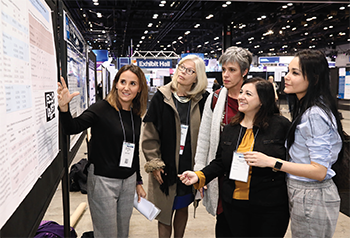
The Poster Hall drew crowds as researchers presented their work and findings.
CHICAGO—Findings on opioid efficacy, serum urate in osteoarthritis and arthrocentesis headlined the top research of the year discussed in the first half of a session at the 2018 ACR/ARHP Annual Meeting. The second half covered basic science findings, including summaries of new insights into the gender bias in autoimmune diseases, platelet microparticles in scleroderma and fibroblasts in rheumatoid arthritis (RA).
Big Findings
Peter A. Merkel, MD, MPH, chief of rheumatology at the University of Pennsylvania in Philadelphia, reviewed clinical research over the past year following discussions with international experts. In the SPACE randomized clinical trial, 240 patients with back pain or hip or knee osteoarthritis pain were randomized to receive opioid or non-opioid medications in individually tailored regimens. The main findings: No difference was found in pain’s interference with function between the groups, and the non-opioid group had less pain intensity. Dr. Merkel said the trial “provides clinical guidance and support to a strategy of avoiding use of opioids for treatment of chronic musculoskeletal pain.”1
In a longitudinal cohort study, researchers found serum urate levels predict joint-space narrowing in patients without gout who have medial knee osteoarthritis (OA).2 The findings, Dr. Merkel said, suggest uric acid plays some role in OA but don’t show causality. They raise the question of whether urate-lowering treatment could prevent OA progression in some patients, and highlight the increasingly recognized complexity of OA pathogenesis.
He also highlighted a retrospective chart review involving 1,050 arthrocentesis/joint injection procedures at Mayo Clinic for patients taking direct-acting oral anticoagulants.3 The procedures all involved only outpatient visits. Investigators found no episodes of bleeding after any of the procedures. “These data are helpful and reassuring to clinicians and patients,” Dr. Merkel said.
He also tackled the enormous amount of literature published during 2017 and 2018 (more than 100 papers) on rheumatic disease associated with the use of checkpoint inhibitors, which has skyrocketed in cancer treatment. The reports of new or exacerbated cases linked to the drugs include inflammatory arthritis, lupus, myositis, sarcoidosis, vasculitis and other illnesses.
The bottom line of these reports, Dr. Merkel said, is that rheumatologists must become more aware and comfortable with the problem, help study the issue with high-quality research and develop treatment strategies and guidelines. “This is an important and rapidly expanding area of clinical rheumatology,” he said.
‘These data are helpful & reassuring to clinicians & patients.’—Dr. Merkel
Basic Science Findings
In the basic science year-in-review talk, Virginia Pascual, MD, director of the Gale and Ira Drukier Institute for Children’s Health at Weill Cornell Medicine, New York, covered several intriguing findings offering avenues to explore treatment options.
Work published in January out of the University of Toulouse, France, turns a common perception on its head.4 Women carry two X chromosomes, some with essential genes that affect autoimmunity, and it’s been generally understood that one of the X chromosomes is inactivate so the final “dose” of the genes is similar to that provided by the male.
This doesn’t actually happen all the time in women, the researchers showed.
They designed probes to detect the transcript of toll-like receptor 7 (TLR7) in the two different alleles that every cell might express, and they found the dose in female cells was not the same as in males. The investigators directly visualized the TLR7 transcript in the two chromosomes in monocytes and interferon-producing plasmacytoid cells, which are relevant to lupus.
“There is unequivocal evidence that this X chromosome is not getting appropriately inactivated,” Dr. Pascual said. “This paper sheds new light into mechanisms that might be very important in the predisposition to lupus.”
In other work, investigators in Milan, Italy, found that platelet microparticles (which sustain the activation of neutrophils in scleroderma [SSc]) overexpress HMGB1, a cytokine that mediates the response to injury and inflammation.5 But this overexpression was not seen in healthy controls, or in lupus patients.
Autophagic flux (a measure of cell destruction through the normal physiological process of autophagy) and NETosis (the killing of pathogens with a sticky “net” of chromatin expelled by neutrophils) are increased in neutrophils stimulated by microparticles derived from SSc platelets. “Maybe this will be a potential pathogenic player, but also a potential biomarker to follow disease in humans,” Dr. Pascual said.
In another important paper, she said, researchers used a genomic approach to identify three distinct classes of fibroblasts in the synovial membrane of RA patients.6 One of these subsets (characterized by expression of the proteins podoplanin, THY1 membrane glycoprotein and cadherin 11, but without CD34) was found to be expanded threefold in patients with RA compared to those with OA. Investigators found the fibroblasts of this type localize to the perivascular zone in the inflamed synovium and secrete pro-inflammatory cytokines.
“New genomic tools,” Dr. Pascual said, “are helping us uncover new classes of stromal cells, fibroblasts, that might be targets for therapy.”


